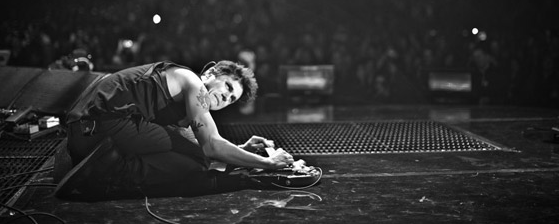
"I had this vision - sitting by a window on a rainy afternoon, just playing guitar. I said to myself, 'If I have enough strings and electricity, I can play guitar forever. I don't need anything else.'"
- John Mayer to Rolling Stone Magazine, February 2007
- John Mayer to Rolling Stone Magazine, February 2007
the coveted "Song of The Year" award at the age of 28. He has earned a host of awards ranging from the "Hal David Starlight Award" at the 37th Annual Songwriters Hall of Fame induction ceremony to "Worlds Best Selling Rock Act" in 2005 at the World Music Awards. He has written for Esquire magazine, has had a hand in designing everything from electric guitars and amplifiers to clothing and sneakers, and has become one of the most followed personalities on twitter. He started a non-profit organization called the "Back To You" fund, which fundraises in the areas of health care, education, and the arts. He has dated Jessica Simpson, Jennifer Aniston, Jennifer Love Hewitt, Minka Kelly, and has provoked Taylor Swift to write two songs about him. He will soon be hosting a television show entitled "John Mayer Has a TV Show". Is this guy good or what? It is no wonder why so many people (men) despise him... and by despise I mean "envy".
I personally find the development of John Mayer's musicality highly relatable, and I think he represents that kid who was disillusioned by the world and withdrew into his own paralleled construct. Surprisingly, it would be Michael J. Fox's guitar performance as Marty McFly in "Back to The Future" who would stir Mayer's interest in the instrument, and upon hearing Texas-Blues sensation Stevie Ray Vaughan, there would be no turning back. His fate was sealed.
He became quite obsessed with guitar and his singular focus worried his parents, who took him to see a psychiatrist twice. Mayer has stated that "The contentious nature of his parents' marriage led him to disappear from society and create his own world that he could believe in." After suffering from cardiac dysrhythmia and being hospitalized for a weekend, the songwriter in him was born. Shortly after this he would begin suffering from panic attacks and live with the fear of having to enter a mental institution. Mayer still suffers from anxiety to this day and manages it with Xanax, an anti-anxiety drug.
Mayer would attend Berklee College of Music for two semesters before dropping out and moving to Atlanta, where he would eventually achieve success with two pop albums, "Room for Squares" in 2001 and "Heavier Things" in 2003. Around 2005, his musical direction would change, announcing that he was "closing up shop on acoustic sensitivity." It was around this time that the inner-blues guitarist from his childhood emerged with a style that synthesized the likes of Eric Clapton, BB King, Stevie Ray Vaughan, and of course Jimi Hendrix. He formed a blues trio, reminiscent of the raw power of Cream and would eventually release "Continuum" in 2006, a modern blues masterpiece.
In 2003, Erik Crawford of Allmusic asked "Is he the consummate guitar hero exemplified when he plays a cover of Stevie Ray Vaughan's 'Lenny', or is he the teen idol that the pubescent girls shriek for after he plays 'Your Body Is A Wonderland?''. The answer is both - whether it be dominating the radio stations with a catchy pop tune or eliciting a stadium-wide standing ovation during a soulful rendition of the "Gravity" solo, John Mayer is always up to the challenge. Sometimes his public image derails his skills as a musician, but this is only because he strives for so much. His ambitions go far beyond just music and it is because of this that he is often the center of attention. This attention would be misplaced if he was an incompetent musician, but the fret-work presented below speaks for itself, he is incredible. The guitar community should be forever grateful for the attention he brings to the instrument. After all, possessing the talent and capabilities of writing hit pop songs and the skill and virtuosity to belt out cutting edge blues guitar solos are two completely different musical elements, and John Mayer has both and more.
Gravity
Solo 1 : 2:05 - 2:58
Solo 2 : 4:55 - 8:20
The "Gravity" solo is John Mayer's showcase performance and generally occupies the encore slot of
his setlist. It is based in G major and follows a slow blues chord progression and draws heavily on Em, Bm, and Am while the bass line plays it straight in G and makes use of C in the latter measures. A very clear influence can be heard from Stevie Ray Vaughan's instrumental "Lenny". While most slow blues songs opt for a 12/8 time signature, "Gravity" is in 6/8, causing a further expansion of time making it extremely slow-moving. This allows for a lot of negative space to be integrated into the structure of the guitar part. Vibratos are glorified by this tempo as can be seen in the first solo as well as the intro, allowing a control of oscillation speed which would otherwise be neglected due to a crowded rhythm section. As can be seen in this live performance, techniques such as rakes are exemplified, producing a chopped-up percussive tonal quality which stands in contrast with the delicate vibratos.
The second solo is where Mayer makes extensive use of the slow time signature, articulating quick blues phrases reminiscent of BB King and Stevie Ray Vaughan which propogate at lightning speeds due to being painted upon such a slow moving canvas. The bass part settles in to a repetitive quick ascension and slow dissension before landing back on the typical G bass line. Mayer uses this quick ascension as a slingshot as can clearly be seen from 5:45 - 6:00. This ascension is the primary melody used in this solo before settling into aposition of repetitive stock phrasings, sometimes manifested by trills (behind his back), and sometimes manifested by extremely tight vibratos. Mayer can often be seen playing two-note harmonies during his final melodic ascension initially making use of G and E (Root, 7th inversion) as can be seen while he's playing on the floor at 7:13 and pursuing it all the way up the neck.
his setlist. It is based in G major and follows a slow blues chord progression and draws heavily on Em, Bm, and Am while the bass line plays it straight in G and makes use of C in the latter measures. A very clear influence can be heard from Stevie Ray Vaughan's instrumental "Lenny". While most slow blues songs opt for a 12/8 time signature, "Gravity" is in 6/8, causing a further expansion of time making it extremely slow-moving. This allows for a lot of negative space to be integrated into the structure of the guitar part. Vibratos are glorified by this tempo as can be seen in the first solo as well as the intro, allowing a control of oscillation speed which would otherwise be neglected due to a crowded rhythm section. As can be seen in this live performance, techniques such as rakes are exemplified, producing a chopped-up percussive tonal quality which stands in contrast with the delicate vibratos.
The second solo is where Mayer makes extensive use of the slow time signature, articulating quick blues phrases reminiscent of BB King and Stevie Ray Vaughan which propogate at lightning speeds due to being painted upon such a slow moving canvas. The bass part settles in to a repetitive quick ascension and slow dissension before landing back on the typical G bass line. Mayer uses this quick ascension as a slingshot as can clearly be seen from 5:45 - 6:00. This ascension is the primary melody used in this solo before settling into aposition of repetitive stock phrasings, sometimes manifested by trills (behind his back), and sometimes manifested by extremely tight vibratos. Mayer can often be seen playing two-note harmonies during his final melodic ascension initially making use of G and E (Root, 7th inversion) as can be seen while he's playing on the floor at 7:13 and pursuing it all the way up the neck.
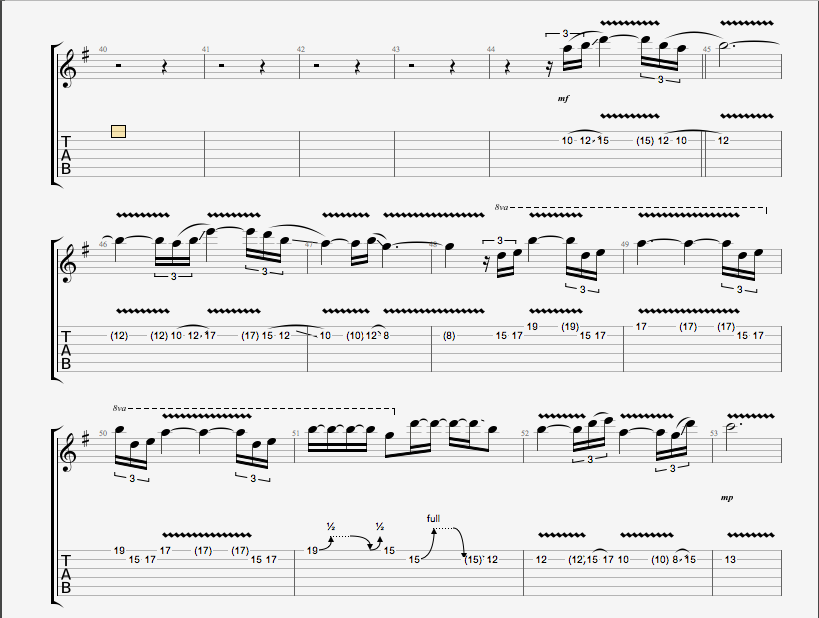
TONE: Keeley Katana (solo 1), Keeley Katana + Blues Driver (solo 2)
Bold As Love
Solo 2:10 - 2:56
John Mayer's cover of Jimi Hendrix's "Bold as Love" utilizes the same Curtis Mayfield "embellished chord" style as the original. The "embellished chord" style is a particular way of intermingling chords and theirrespective scales in order to create very specific melodies. This is the same style that Hendrix used to write "Little Wing" and John Frusciante used to write "Under The Bridge". Mayer opts for a much cleaner tone than Jimi Hendrix's original track, which featured a slightly overdriven guitar. The pleasing nature of John Mayer's guitar sound can be highly accredited to his special designed "Big Dipper" pickups, which feature a scooped midrange. In 2007, he stated "I'm going for the biggest, fluffiest, tubbiest sound. I want my guitar to sound like Sting's voice - thick, on the bottom." in Mayer has stated on several occasions. Axis:Bold as Love string harmonies, such as in measures 85 and 86 can be traced to Stevie Ray Vaughan. The use of unison bends in measures 73, 74, and 75 is very Hendrixian stylistically, but utilizes a different articulation. Generally when Jimi performed unison bends he hit both string simultaneously causing a wave of beat frequencies, such as in "All Along The Watchtower". In this case, Mayer instead articulates each note individually and utilizes it as a constant ascension. The phrasing used in measure 77 and 78 are quite original in structure, which is one of Mayer's goals as a guitarist. "I want to figure out my own phrasing, my own vocabulary, I would like to get to the point where someone says, 'I can tell that's John Mayer.'" - Mayer to Rolling Stone Magazine.
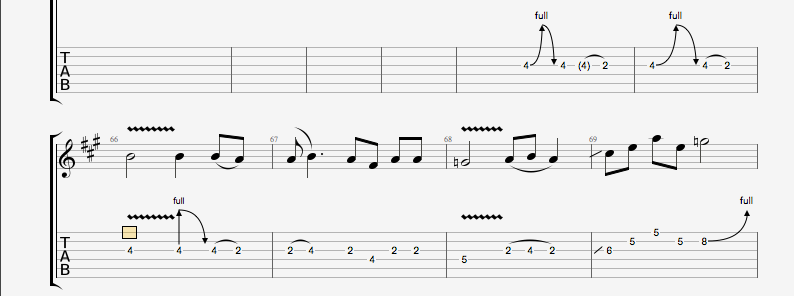
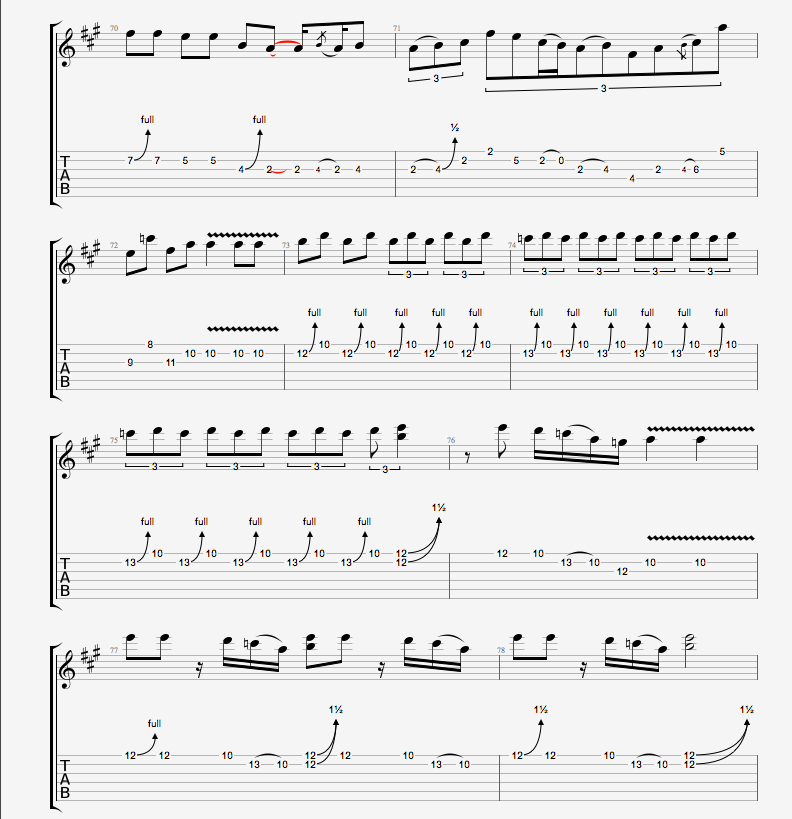
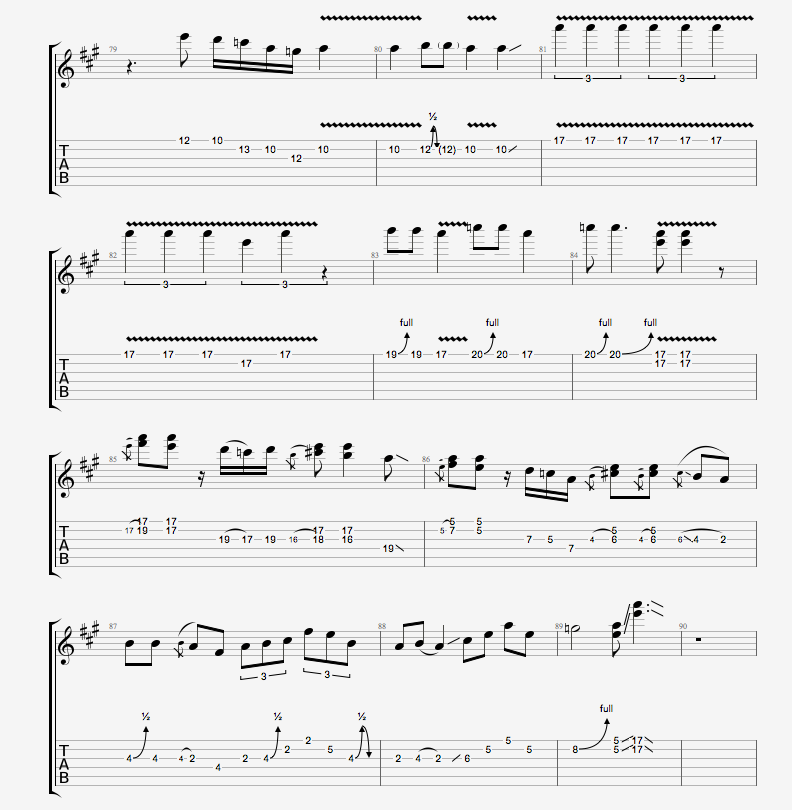
TONE: Keeley Katana, Ibanez Tubescreamer
Belief
Solo 2:26 - 4:00
The "Belief" solo is a short and sweet consolidation of various blues phrasings which utilizes a wide range of dynamics to invoke emotions. It is an excellent solo to study from a blues perspective, being a concise package of influence from the blues pioneer guitarists. On the album version, the first note begins as a slide into an accentuated vibrato. This move is very reminiscent of techniques used by Freddie King, although Freddie would often substitute a bend for the slide before landing on the vibrato. In measure 63, John embarks on a measure of quick ascension and descension notes with a very decisive sense of dynamics to the point where at times it sounds as if the guitar drops out completely. This technique has a very Buddy Guy feel to it, who John has cited as being one of his influences on various occasions. The two notes played in unison in measures 66 and 67 are the unmistakable gritty raw energy of a young Eric Clapton, reminiscent of moves made in "Crossroads" during his days with Cream.
In this specific live version, many deviations are made from the original. The initial phrase is extremely interesting, and will surprise one who is only accustomed to the album version. John plays a series of four ascending notes ending on the root before quickly hitting the inverted D minor triad on the top 3 strings and bending that B string to root in a way that Freddie King would be proud of. The composition as a whole gets very funky around the 3:00 mark as all of the instruments with the exception of the drums drop out and reemerge in syncopated patterns. It is also very apparent by the slide at 2:56 that an echo effect is engaged during this solo. Finally, John's lead resurfaces at 3:40 in a beautiful screaming phrase using a selection of notes similar to the initial phrase of this solo. The smile on his face at around 3:58 reflects how pleased he was at this particular performance.

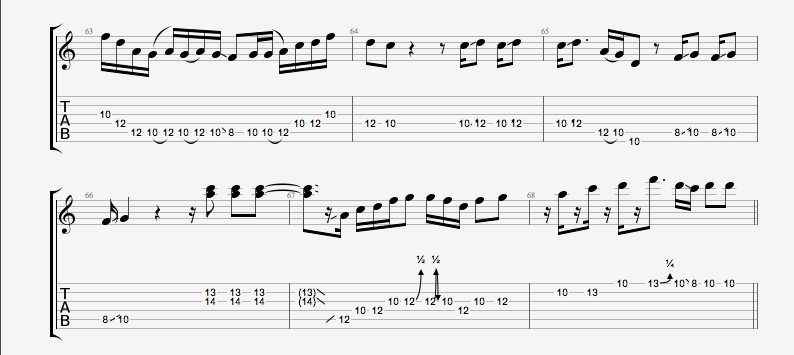
TONE: Keeley Boss Blues Driver, Echo
Sources
"John Mayer." Wikipedia, The Free Encyclopedia. Wikimedia Foundation, Web. 8 May. 2011.
All tablatures provided by www.ultimate-guitar.com
I am not the original owner of any of the youtube videos presented
All tablatures provided by www.ultimate-guitar.com
I am not the original owner of any of the youtube videos presented
